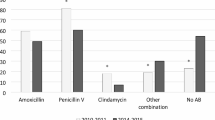Abstract
Purpose
The objective of this study was to compare the efficacy of a single oral dose of clindamycin with a 24-h protocol of clindamycin administration in local buccal onlay grafting procedures.
Material and methods
A prospective randomized study in 124 patients was performed. Eligible patients were randomized to receive antibiotic prophylaxis either as a single dose (group I) or over a 24-h period (group II). In both groups prophylaxis started with an oral dose of 600 mg clindamycin 1 h before surgery, followed by either placebo or 300 mg clindamycin every 6 h. The primary endpoint of this study was wound infection at the receptor site within 8 weeks after surgery. Secondary outcome measurements included postoperative infections at the donor site and adverse events as a result of antibiotic administration.
Results
The mean age of the patients was 35.9±10.1 years (range 18–59 years). Infections at the receptor site were seen in two patients (3.2%, 95% CI 0–7.6%) of the single-dose group and in three patients (4.8%, 95% CI 0–10.1%) of the 24-h group. Infection at the donor site occurred in four patients (6.4%, 95% CI 0–12.5%) of the single-dose group and in two patients (3.2%, 95% CI 0–7.6%) of the 24-h group. Postoperative infections were predominantly caused by α-hemolytic streptococci sensitive to penicillin.
Conclusions
No statistically significant difference was found between the prophylactic single dose of clindamycin and the 24-h regimen of clindamycin with regard to postoperative infection in patients undergoing local bone augmentation procedures.
Zusammenfassung
Ziel
Ziel dieser Studie war der Vergleich der Wirksamkeit einer einzelnen oralen Dosis Clincamycin mit der Clindamycingabe nach einem 24-h-Schema bei lokalen oralen Onlay-Transplantationsverfahren.
Material und Methoden
Es wurde eine prospektive randomisierte Studie an 124 Patienten durchgeführt. In Frage kommende Patienten wurden randomisiert einer Antibiotikaprophylaxe entweder als Einzeldosis (Gruppe I) oder über 24 h (Gruppe II) zugeteilt. In beiden Gruppen begann die Prophylaxe mit einer oralen Dosis von 600 mg Clindamycin 1 h vor der Operation, dieser folgte entweder die Gabe von Placebo oder 300 mg Clindamycin alle 6 h. Der primäre Endpunkt der Studie war eine Wundinfektion am Transplantationsort innerhalb von 8 Wochen nach Operation. Parameter des sekundären Endpunkts umfassten postoperative Infektionen an der Entnahmestelle und Nebenwirkungen als Folge der Antibiotikagabe.
Ergebnisse
Das mittlere Alter der Patienten betrug 35,9±10,1 Jahre (Spanne 18–59 Jahre). Infektionen am Transplantationsort wurden bei 2 Patienten (3,2%; 95%-KI 0–7.6%) der Einzeldosisgruppe und bei 3 Patienten (4,8%; 95%-KI 0–10.1%) der 24-h-Gruppe beobachtet. Eine Infektion an der Entnahmestelle trat bei 4 Patienten (6,4%; 95%-KI 0–12.5%) der Einzeldosisgruppe auf und bei 2 Patienten (3,2%; 95%-KI 0–7.6%) der 24-h-Gruppe. Postoperative Infektionen wurden überwiegend durch penicillinempfindliche α-hämolysierende Streptokokken verursacht.
Schlussfolgerungen
Ein statistisch signifikanter Unterschied zwischen der prophylaktischen Gabe von Clindamycin als Einzeldosis und nach einem 24-h-Schema wurde im Hinblick auf postoperative Infektionen bei Patienten, die sich lokaler Knochenaugmentationsmaßnahmen unterzogen, nicht festgestellt.
Similar content being viewed by others
References
Antoun H, Sitbon JM, Martinez H, Missika P (2000) A prospective randomized study comparing two techniques of bone augmentation: onlay graft alone or associated with a membrane. Clin Oral Implants Res 12:632–639
Binahmed A, Stoykewych, Peterson L (2005) Single preoperative dose versus long-term prophylactic antibiotic regimens in dental implant surgery. Int J Oral Maxillofac Implants 20:115–117
De Carvalho PS, Vasconcellos LW, Pi J (2000) Influence of bed preparation on the incorporation of autogenous bone grafts: a study in dogs. Int J Oral Maxillofac Implants 15:565–570
Gynther GW, Kondell PA, Moberg LE, Heimdahl A (1998) Dental implant installation without antibiotic prophylaxis. Oral Surg Oral Med Oral Pathol Oral Radiol Endod 85:509–511
Hossein K, Dahlin C, Bengt A (2005) Influence of different prophylactic antibiotic regimens on implant survival rate: a retrospective clinical study. Clin Implant Dent Relat Res 7:32–35
Laskin DM, Dent CD, Morris HF, Ochi S, Olson JW (2000) The influence of preoperative antibiotics on success of endosseous implants at 36 months. Ann Periodontol 5:166–174
Lindeboom JA, van den Akker HP (2003) A prospective placebo-controlled double-blind trial of antibiotic prophylaxis in intraoral bone grafting procedures: a pilot study. Oral Surg Oral Med Oral Pathol Oral Radiol Endod 96:669–672
Lindeboom JA, Baas EM, Kroon FH (2003) Prophylactic single-dose administration of 600 mg clindamycin versus 4-time administration of 600 mg clindamycin in orthognathic surgery: a prospective randomized study in bilateral mandibular sagittal ramus osteotomies. Oral Surg Oral Med Oral Pathol Oral Radiol Endod 95:145–149
Misch CM (1997) Comparison of intraoral donor sites for onlay grafting prior to implant placement. Int J Oral Maxillofac Implants 12:767–776
Mueller SC, Henkel KO, Neumann J, Hehl EM, Gundlach KK, Drewlow B (1999) Perioperative antibiotic prophylaxis in maxillofacial surgery: penetration of clindamycin into various tissues. J Craniomaxillofac Surg 27:172–176
Sethi A, Kaus T (2001) Ridge augmentation using mandibular block bone grafts: preliminary results of an ongoing prospective study. Int J Oral Maxillofac Implants 16:378–388
Author information
Authors and Affiliations
Corresponding author
Rights and permissions
About this article
Cite this article
Lindeboom, J.A.H., Tuk, J.G.C., Kroon, F.H.M. et al. A randomized prospective controlled trial of antibiotic prophylaxis in intraoral bone grafting procedures: single-dose clindamycin versus 24-hour clindamycin prophylaxis. Mund Kiefer GesichtsChir 9, 384–388 (2005). https://doi.org/10.1007/s10006-005-0650-4
Published:
Issue Date:
DOI: https://doi.org/10.1007/s10006-005-0650-4
Keywords
- Intraoral bone grafting
- Randomized controlled trial
- Clindamycin
- Antibiotic prophylaxis
- Postoperative infection




